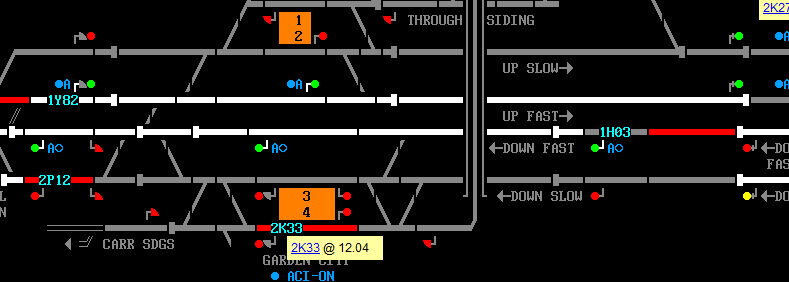Page 1 of 1
| Train speed after clearing signals. 28/03/2018 at 19:51 #107071 | |
|
bugsy
1832 posts |
I would like to know if the circumstances that I describe below would actually occur in reality. I have train 1H03 approaching signal 597 on the Down Fast at Welwyn Garden City. I am manually controlling this signal and the next two signals (607 and 619), but owing to other activities elsewhere in the sim, I have failed to clear them after the preceding train. I notice this and quickly clear them when 1H03 is travelling toward signal 597 at approximately 67 mph. To my disappointment, 1H03 continued to brake until it’s speed was 40 mph. This seems unnecessary to me. After all, it now has a clear path. I would be interested in comments and an explanation. Thanks Bugsy See attached a screenshot.  Post has attachments. Log in to view them. Everything that you make will be useful - providing it's made of chocolate. Log in to reply |
| Train speed after clearing signals. 28/03/2018 at 19:56 #107075 | |
|
GeoffM
6415 posts |
The train won't accelerate / stop braking until it is in sight of the signal. Without in-cab signalling with continuous updates (certainly not here!), this is indeed how trains behave in real life.
SimSig Boss Log in to reply The following users said thank you: bugsy, TUT, VInce |
| Train speed after clearing signals. 29/03/2018 at 08:46 #107083 | |
|
kbarber
1779 posts |
I wonder if one of the issues is sighting distances. Correct me if I'm wrong: doesn't Simsig assume a signal is visible at 200m but not before? In real life, there are significant stretches of the ECML where it's possible to see the next two signals with ease; in that case a driver would, of course, start to accelerate as soon as the signal ahead steps up. But there are also places where curvature or obstructions limit visibility. Unless devs have full information on the sighting distance for every signal (and the time and inclination to input it... rather them than me on a big sim like this!) it is impossible, in practical terms, to offer perfect simulation of real life. I guess it's one of the few compromises we have to put up with. Log in to reply The following user said thank you: VInce |
| Train speed after clearing signals. 29/03/2018 at 09:06 #107084 | |
|
JamesN
1626 posts |
kbarber in post 107083 said:I wonder if one of the issues is sighting distances.Default sighting distance is 300m - this is customisable by the sim developer where true values are known. Log in to reply |
| Train speed after clearing signals. 29/03/2018 at 10:51 #107086 | |
|
clive
2823 posts |
JamesN in post 107084 said:To clarify: it can be overridden for any single signal or, independently, the default can be changed. Log in to reply The following user said thank you: JamesN |
| Train speed after clearing signals. 29/03/2018 at 10:53 #107087 | |
|
clive
2823 posts |
kbarber in post 107083 said:I learned about four-aspect signalling as a child by standing on the platform at Leigh-on-Sea and seeing about six signals ahead. (At least, it felt like six in memory; it may have been less.) Log in to reply |
| Train speed after clearing signals. 30/03/2018 at 09:38 #107101 | |
|
kbarber
1779 posts |
clive in post 107087 said:kbarber in post 107083 said:Could well have been Clive. I recall when I became Station Supervisor at Barking, the Station Manager suggested I have a cab ride to get a feel for the patch. (The rigours of learning a new job :-) ) There were stretches where multiple signals were in sight. The really interesting stretch was Fenchurch - Stepney East (now renamed Limehouse), where the signals were 200yd apart and the AWS ramp for each signal was at the signal in rear. I think even at the low speeds authorised along there, there were multiple double-yellow sequences.I learned about four-aspect signalling as a child by standing on the platform at Leigh-on-Sea and seeing about six signals ahead. (At least, it felt like six in memory; it may have been less.) Log in to reply The following user said thank you: BarryM |